MacBook Pro with Retina display review (13-inch, 2015)
Hardware (but mostly the trackpad)
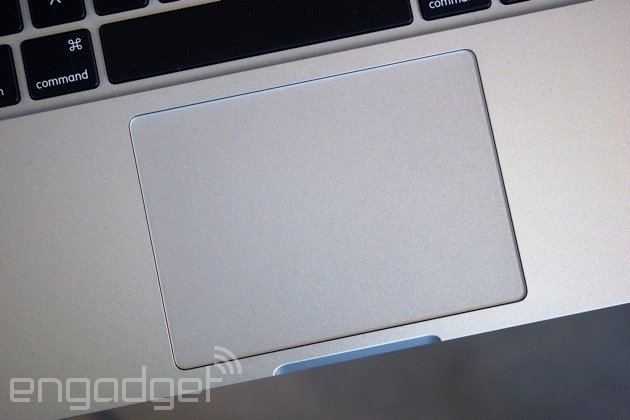
If you already own a recent MacBook Pro, or have even futzed around an Apple Store, then you know what to expect here. The new MBP, like so many before it, is constructed from a seamless block of machined aluminum, with springy, well-spaced keys and a crisp 2,560 x 1,600 display, framed by a thin, barely there bezel. As before, the machine measures a slim 0.71 inch thick, though Apple is listing the weight as slightly heavier this time around: 3.48 pounds, as opposed to 3.46. Big whoop.
Around the edges, you get the same selection of ports: two USB 3.0 connections, a full-sized HDMI socket, two Thunderbolt 2 ports, an SD card slot and a headphone jack. Nope, no USB Type-C ports like on the new MacBook -- at least not this time around.
Oh, and the aluminum lid and chassis are still scratch-prone. With that, I am done talking about the MacBook Pro's hardware.
Except for the new trackpad, of course. I have plenty more to say about that. For starters: What a risky thing for Apple to do, replacing the touchpad that's already the best in its class. Reviewers like it; users seem to like it. So what's the problem? If it ain't broke, don't fix it, right? Right. Except for the fact that the Force Touch pad can do things the Mac regular trackpad can't. I already gave the example of pressing down on the skip keys in QuickTime to rewind or fast-forward at 60x speed. But there are other use cases: You can use the "Force Click" in Safari to get Wikipedia previews and word definitions. You can annotate in Mail and Preview. Speaking of Mail, you can Force Click on an address and see it in a pop-up map. You can also use it in Finder to preview files. And those are just built-in Mac apps; developers can build this feature into third-party apps as well.
Before I get into the utility of all this, though, allow me to take a step back and explain how this thing works. Though it's about as spacious as the one on the old model, the new Force Touch pad does away with the old-school "diving board" -- the hinge mechanism that makes it easier to press down on the bottom portion of a touchpad than on the top. In fact, the trackpad here doesn't have any buttons; there's nothing to depress when you bear down with your finger. Instead, Apple fools you into believing you're clicking something. How? With the use of a "Taptic Engine" -- a bunch of wires coiled around a magnetic core that provide vibrating haptic feedback to match whatever you're doing onscreen. It's so convincing, in fact, that I would sometimes forget it wasn't a normal trackpad -- until I turned the machine off, anyway, and was left with a stiff piece of glass.
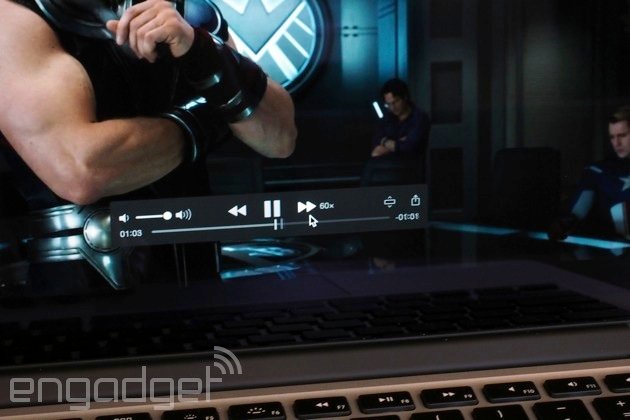
That said, these "button presses" don't feel like using a touchpad on other MacBooks. If you're coming from an older model, as I am, you'll notice the new trackpad feels shallower; even though Apple makes it feel like you're clicking something, your finger isn't "pressing down" as far as it normally would. This was an adjustment for me, but I found a few ways to get past it. First off, I turned on the "tap-to-click" option in the settings, which helped me avoid "clicking" when it initially felt too weird. (To be fair, I always have tap-to-click enabled on my own Mac, so this didn't feel like much of a workaround for me.) Secondly, there's also an option in the settings to adjust the click pressure. Moving it from "medium" (the default) to "light" also helped soften the learning curve.
Mostly, though, it just took time. After two days with the Force Touch pad, I was more or less used to it. Heck, if I weren't switching back and forth between the new Pro and my own MacBook Air, I might have adjusted even sooner.
But back to my original question: Was this all worth it? Do the benefits of a pressure-sensitive touchpad outweigh the inconvenience of taking away the one people are used to? I'm not convinced they do. In Safari, at least, the novelty wore off quickly, particularly since it often took me several tries to get it right. Sure, it's cool to be able to Force Click on a word and be able to see a dictionary definition or a Wikipedia preview, but because I never fully got the hang of the gesture, it was far easier to just open a new browser tab and do a quick Google search. In that respect, the Force Touch pad didn't change my habits. Same with Finder: When you Force Click on a thumbnail to preview it, the actual "preview" is still small, unless you give it a second, harder press at which point it stretches to a fuller size. I'd still prefer to use a keyboard shortcut: hitting the space bar to open a much larger preview.
I did enjoy the super-fast fast-forwarding, though. For me, at least, that might be the best and most practical reason to have a pressure-sensitive trackpad. Even so, the Force Touch feels like just another nice-to-have feature; I don't mind that it's there, and I ultimately got used to it, but it's also not something I particularly needed. It's certainly not essential on the level of the Retina display, which basically spoiled the lower-res MacBook Air screen for me and many other users. Every Mac should have a Retina panel; the Force Touch trackpad I can take or leave at this point.
Performance and battery life
| OS X benchmarks | Geekbench | Xbench | Battery life |
|---|---|---|---|
| 13-inch MacBook Pro with Retina display (early 2015, 2.7GHz Core i5, Intel Iris 6100) | 6,293 (32-bit) / 7,062 (64-bit) | 487 | 11:23 |
| 13-inch MacBook Pro with Retina display (late 2013, 2.4GHz Core i5, Intel Iris graphics) | 6,288 (32-bit) | 428 | 11:18 |
| 13-inch MacBook Air (mid 2013, 1.3GHz Core i5, Intel HD Graphics 5000) | 6,021 (32-bit) | 304 | 12:51 |
| 13-inch MacBook Pro with Retina display (late 2012, 2.5GHz Core i5, Intel HD Graphics 4000) | 6,812 (32-bit) | 378 | 6:07 |
| 13-inch MacBook Pro (mid 2012, 2.5GHz Core i5, Intel HD Graphics 4000) | 6,817 (32-bit) | 368 | 6:51 |
| 13-inch MacBook Air (mid 2012, 1.8GHz Core i5, Intel HD Graphics 4000) | 6,195 (32-bit) | 321 | 6:34 |
The refreshed MacBook Pro arrives not long after Intel started shipping its fifth-generation Core processors, code-named "Broadwell." As you'd expect, then, the Pro comes with your choice of new Core i5 and i7 chips, though only dual-core for now, as Intel hasn't released its quad-core Broadwell processors yet. Also not surprising: The performance boost is in many ways a fairly modest one. When Intel first announced these chips, it said we should only expect a 4 percent gain in productivity-oriented tasks. So it makes sense, then, that the MacBook Pro's results in general-performance benchmarks are only marginally better than they were a year and a half ago. Armed with a 2.7GHz Core i5 processor and 8GB of RAM, I saw less than a 100-point difference in tests like Geekbench and Xbench.
That said, Broadwell promises some bigger gains in graphics -- after all, a whole two-thirds of the die area is dedicated to graphics. In particular, according to Intel, Broadwell machines should deliver a 22 percent improvement in 3D graphics benchmarks, and up to 50 percent faster video-conversion time. And the new MacBook Pro actually does most Broadwell machines one better: As before, it uses the chip maker's high-end "Iris" solution, instead of the usual Intel HD graphics. Given that the MBP is mainly intended for prosumers and creative pros, I decided to test the Iris 6100 graphics by loading up Final Cut Pro with a handful of 4K clips. Aside from one dropped frame -- brought on by trying to add a transition -- video playback was smooth. In fact, I was usually able to add effects in real time without causing any hiccups or slowdowns.
In gaming, meanwhile, I saw a slight bump in Batman: Arkham City (the same game I used to test the late 2013 model), with frame rates rising from 32 fps to 33. Not really surprising, that: The Pro was never intended as a gaming machine, per se.
| Battery life | |
|---|---|
| Apple MacBook Pro with Retina display (13-inch, 2015) | 11:23 |
| MacBook Air (13-inch 2013) | 12:51 |
| HP Spectre x360 | 11:34 |
| Apple MacBook Pro with Retina display (13-inch, late 2013) | 11:18 |
| Chromebook Pixel (2015) | 10:01 |
| Samsung ATIV Book 9 Plus | 8:44 |
| Dell XPS 13 (2015) | 7:36 |
| Lenovo Yoga 3 Pro | 7:36 |
| Acer Aspire S7-392 | 7:33 |
| Microsoft Surface Pro 3 | 7:08 |
Even more than the new processor, though, the biggest improvement might be disk speeds. Though the Retina display MacBook Pro has had PCIe-based SSDs (which are faster than mSATA ones) for about a year and a half now, Apple says the PCIe drives used in the latest MBP are twice as fast as the first PCIe SSDs used. Specifically, the company says its new disks can reach peak read speeds of 1.6 GB/s and max sequential write speeds of 1.5 GB/s. Indeed, in the Blackmagic disk test I got average read speeds of 1.3 GB/s, nearly matching the promised rate, although my write speeds came to an average of 643.6 MB/s. That's still higher than just about any other 13-inch laptop I've tested recently; I just couldn't reach those theoretical speeds of one and a half gigabytes per second. In real-world use, this translates to snappy performance, affecting everything from app load times to cold boot-ups (I recorded 13 seconds to get to the login screen).
Apple says the new 13-inch Retina display MacBook Pro is capable of up to 10 hours of web browsing, or up to 12 hours of iTunes video playback. Sure enough, I logged 11 hours and 23 minutes in Engadget's video looping test, using an episode of Breaking Bad I purchased through iTunes. That does indeed match Apple's own estimate, and I suspect I could have actually broken the 12-hour mark had I not chosen such punishing battery settings. (As I do when I test Windows PCs, I kept the MacBook Pro from going to sleep or dimming its display when unplugged.) And hey, even 11.5 hours is impressive for a machine in this class -- the only other system I've seen recently that matches that is HP's Spectre x360.
Still, I was surprised the battery didn't last even longer. First off, though the machine meets Apple's estimates, the Macs I've tested usually exceed expectations -- that's why the late 2013 model, which was rated for nine hours of runtime, actually clocked more than 11 hours. That brings me to point number two: The battery life here more or less matches what I got a year and a half ago. Also, to even achieve flat year-over-year battery life, I had to stick with iTunes; when I played movies through QuickTime and/or used a file I downloaded from somewhere else, the battery life was up to an hour shorter. To be fair, even Intel warned that battery life gains with Broadwell would be fairly modest over last year's processors, but still, I did expect more of an improvement. For the record, at least, other reviewers have noted bigger gains; I'm just not sure why I wasn't able to replicate their test results. I'll continue running some tests and will update this review if anything changes.
Configuration options
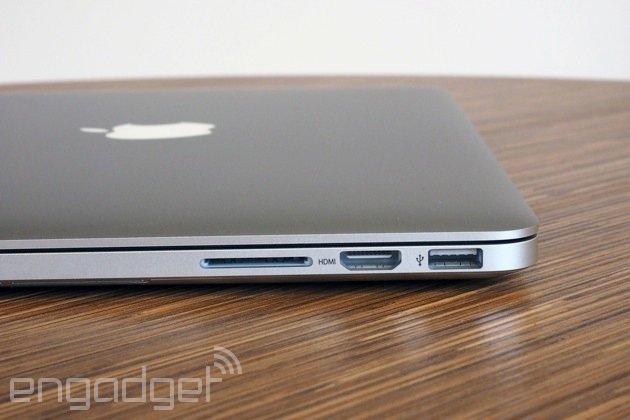
The 13-inch Retina display MacBook Pro starts at $1,299 with a 2.7GHz fifth-generation Intel Core i5 processor, Intel Iris Graphics 6100, 8GB of RAM and a 128GB PCIe-based solid-state drive. From there, you can upgrade to a slightly faster 2.9GHz Core i5 processor for an extra $100, or a 3.1GHz Core i7 CPU for $300. You can also double the RAM to 16GB for $200. Want more storage? Apple also sells a 256GB model ($1,499) and one with a 512GB SSD ($1,799). In the case of the $1,499 model, it has the same specs as the $1,299 variant, just with more storage. If you spring for the $1,799 model with 512GB of storage, though, you'll also get that slightly faster 2.9GHz processor. There's also a $500 1TB SSD option, but it's only offered as an upsell on the $1,799 model.
One thing you won't find on the 13-inch Retina MBP: a discrete graphics option. That's only available on the 15-inch model, and even then, it'll cost you at least $2,499.
The competition
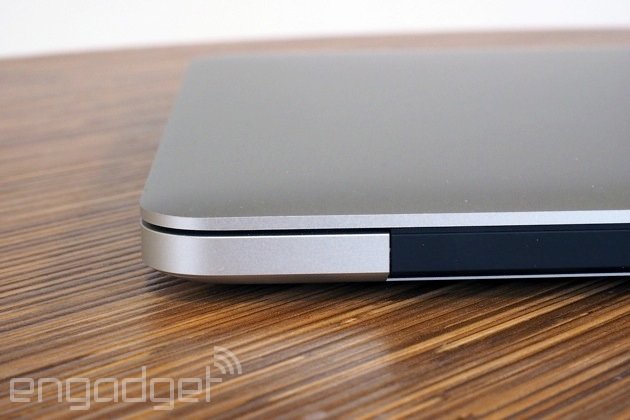
Mac diehards who want a laptop with decent graphics really only have one option: the Retina display MacBook Pro. For those of you who are more OS agnostic, though, you have a few other good PC options. Most don't have quite the same graphics clout as the 13-inch Retina MBP, but they do at least offer similarly sharp screens, premium build quality and long battery life. My personal favorites: the Dell XPS 13 ($800-plus) and HP Spectre x360 ($900-plus). Starting with the Dell, it weighs 2.6 pounds and has a nearly bezel-less (up to 3,200 x 1,800) display that allows it to have a much smaller footprint than a typical 13-inch laptop. All told, it earned a score of 90 in our review, thanks not just to the compact design and crisp screen, but also a comfortable keyboard, fast performance and surprisingly good audio. My only real pet peeve may have been the occasionally temperamental touchpad.
As for the Spectre, it has a 2,560 x 1,440 screen option and a machined aluminum build that some might say was inspired by the MacBook itself. I haven't published my review yet (working on it!), but I can tell you now, the battery life is impressive: about 11.5 hours of video playback in my tests. It's also lighter than the MacBook Pro, with the weight ranging from 3.17 to 3.26 pounds, depending on the configuration. Again, still polishing off my review, but I think it's safe to say this is a solid option if you're looking for a premium, high-performing 13-inch machine.
If, in the end, you find graphics don't matter that much -- and that you can maybe even live without the sharp screen -- Apple's 13-inch MacBook Air is cheaper, at $999. It's also lighter with longer battery life. And it has the old touchpad too, if that's what you prefer, but again, you'd be giving up that sharp screen to get it. Decisions, decisions...
Wrap-up
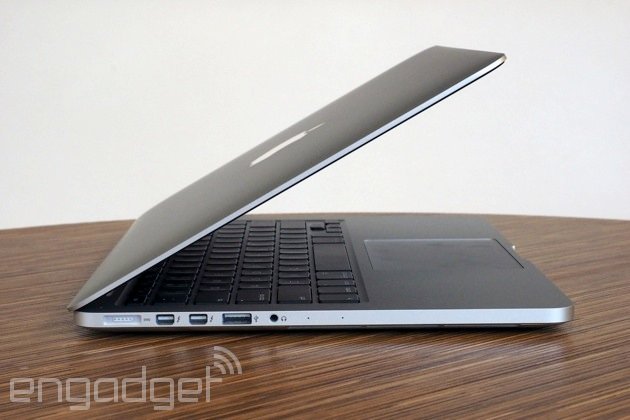
The refreshed Retina display MacBook Pro is mostly an incremental improvement over the previous model, with even faster disk speeds and stronger graphics, along with the same comfortable keyboard, slim design, long battery life and stunning screen. The only area where the MBP represents a possible step backward is the touchpad. To Apple's credit, the pressure-sensitive Force Touch pad is interesting, and has the potential to become more useful as third-party developers start to incorporate the "Force Click" into their own apps. In fact, I'm still curious to see what a potential Force Touch iPhone might look like; perhaps the tech would make more sense there, where having pressure sensitivity doesn't mean forfeiting a best-in-class trackpad. Right now, though, Force Touch feels like a solution to a problem I'm not sure anyone had. At worst, it's a gimmick; at best, it's a nice-to-have feature. Either way, although the new touchpad doesn't feel quite the same as the ol' "diving board," you should at least get used to it quickly.
In the end, too, despite its flaws (the shallower touchpad, the continued lack of a discrete graphics option), the 13-inch Retina display stands as one of the only laptops of this size that offers this level of portability, screen quality and graphics power, not to mention this nice a screen. If you need a lightweight machine with enough processing clout for a little 4K video editing, this is still one of your best bets.
Source: https://www.engadget.com/2015/03/31/macbook-pro-with-retina-display-review-13-inch-2015/